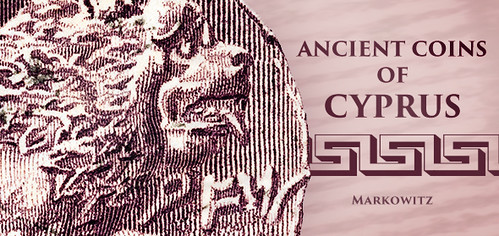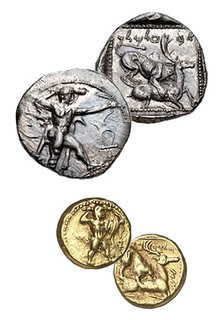
PREV ARTICLE
NEXT ARTICLE
FULL ISSUE
PREV FULL ISSUE
MARKOWITZ ON THE ANCIENT COINS OF CYPRUS
Mike Markowitz published a nice article on the Ancient Coins of Cyprus in CoinWeek Jul 14, 2015. Here's an excerpt. Be sure to read the complete version online.
-Editor

ON A CLEAR DAY, it’s just possible to see the Turkish shore 40 miles (64 km) away from Cape St. Andreas at the northeastern tip of Cyprus. The third-largest island in the Mediterranean after Sicily and Sardinia, Cyprus was settled in the ninth millennium BCE–possibly even earlier–by intrepid Neolithic mariners who somehow managed to cross that same gulf. Much of the copper that made the bronze by which the “Bronze Age” got its name was mined on Cyprus. In Greek, the name of the island and the word for the metal are the same. As a “crossroads of civilizations”, ancient Cyprus was home to a diversity of cultures: Greeks, Phoenicians and an indigenous people know as Eteo-Cypriots, whose language, surviving in a few fragmentary inscriptions, is still largely undeciphered. Egyptian, Assyrian and Persian empires asserted control over the island but allowed local elites to manage their own affairs. By the time coinage came into general use in the fifth century BCE, Cyprus consisted of about 10 “city-kingdoms,” coexisting uneasily.
Salamis Pnytagoras (351-332 BCE) was one of the last independent kings of Salamis, before it was absorbed by Alexander the Great. His fleet assisted Alexander at the epic siege of Tyre (332). Pnytagoras issued impressive gold staters with the head of Aphrodite (also identified as the Phoenician fertility goddess Astarte) on both sides. On the obverse she wears a turreted crown as a city goddess; on the reverse she wears a simple tiara. On Pnytagoras’ silver coinage, Aphrodite is paired with a youthful androgynous image of Apollo. The king’s name is abbreviated to two Greek letters ΠΝ.
Kition
To read the complete article, see:
The Numismatic Bibliomania Society is a non-profit organization promoting numismatic literature. See our web site at coinbooks.org. To submit items for publication in The E-Sylum, write to the Editor at this address: whomren@gmail.com To subscribe go to: https://my.binhost.com/lists/listinfo/esylum All Rights Reserved. NBS Home Page Contact the NBS webmaster 
|

